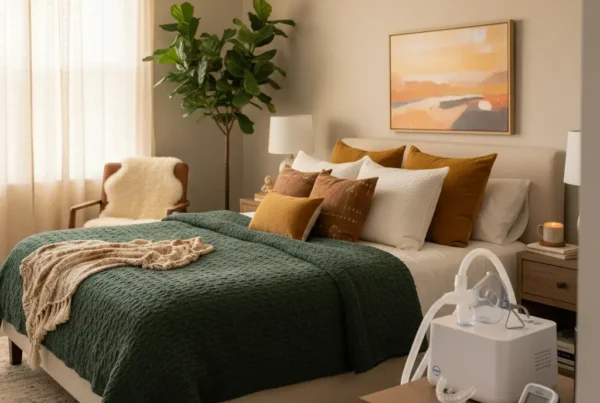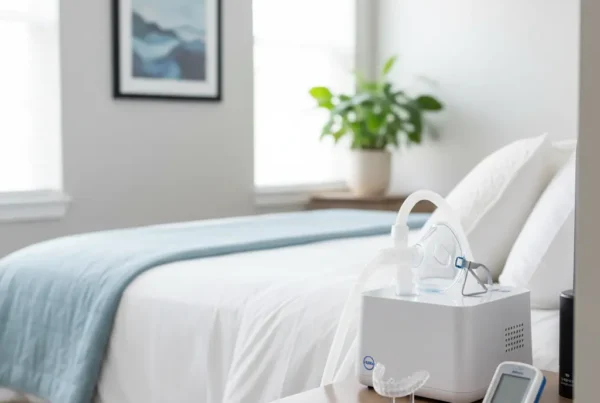Struggling with finding a Sleep Apnea treatment in San Antonio, TX? There’s Hope Beyond CPAP.” Many of us battle with sleep apnea, leading to days filled with tiredness and nights filled with snoring. It’s tough, affecting not just how well we work but also our relationships. And the idea of using a CPAP machine? Not appealing to anyone.
Enter Dr. Chris Cappetta of Fountain of Youth Dental. He gets it. You want better sleep without the hassle of a CPAP. Dr. Cappetta specializes in simpler, effective sleep apnea treatments. Ready to feel energized again? Let’s see how Dr. Cappetta can help make that happen, with solutions that fit your life.
What is Sleep Apnea?
Sleep apnea is a common sleep disorder. It happens when your breathing stops and starts repeatedly as you sleep. This isn’t just about loud snoring. It’s a serious issue that can affect your overall health. Understanding which one you are dealing with, will help you find the right sleep apnea treatment for you.
There are two main types:
- Obstructive Sleep Apnea (OSA): This is the most common type. It occurs when throat muscles relax too much during sleep and block your airway.
- Central Sleep Apnea: This type is less common. It happens when your brain doesn’t send the right signals to the muscles that control breathing.
People with sleep apnea often wake up feeling tired, even after a full night’s sleep. This is because these pauses in breathing can happen hundreds of times a night, preventing deep, restful sleep.
Other signs include:
- Loud snoring
- Gasping for air during sleep
- Morning headaches
- Trouble staying asleep (insomnia)
- Daytime sleepiness (hypersomnia)
- Mouth breathing
- Teeth grinding
- ADD/ADHD
- Bedwetting
- Crooked teeth
Ignoring sleep apnea isn’t just about dealing with snoring and tiredness—it can significantly escalate into major health risks. Studies show that untreated sleep apnea can increase the likelihood of high blood pressure, heart complications, and even diabetes. According to the American Sleep Apnea Association, individuals with untreated sleep apnea are at a higher risk for these conditions. If you’re experiencing symptoms of sleep apnea, it’s crucial to consult a healthcare provider promptly. Source: Johns Hopkins Medicine
What are the Symptoms of Sleep Apnea?
It’s important to recognize the signs of sleep apnea. Knowing these can help you decide when to seek medical advice. Here are the key symptoms:
- Loud Snoring: Persistent snoring can be a sign, especially with other symptoms.
- Pauses in Breathing: Noticed by a partner, where you stop breathing during sleep.
- Gasping or Choking: Waking up gasping or choking.
- Daytime Tiredness: Feeling tired after a full night’s sleep.
- Morning Headaches: Caused by low oxygen levels at night.
- Difficulty Concentrating: Impacting focus and memory.
- Mood Changes: Including irritability and depression.
- High Blood Pressure: Due to disrupted breathing.
If these symptoms sound familiar, it’s important to take action. In the next section, we’ll discuss how Dr. Cappetta at Fountain of Youth Dental in San Antonio, TX, approaches sleep apnea treatment, helping you to overcome these symptoms for a healthier, more energized life.
Health Risks of Sleep Apnea
Sleep apnea affects more than just sleep. Here’s how it impacts health:
- Heart Health: Increases risk of heart issues, including high blood pressure and heart attacks.
- Mental Health: Leads to depression, anxiety, and mood swings.
- Focus and Memory: Causes concentration and memory problems.
- Weight Gain: Can lead to and worsen weight gain.
- Accident Risk: Higher risk of accidents due to daytime fatigue.
It’s crucial to treat sleep apnea to avoid these risks. Next, we’ll discuss Dr. Cappetta’s treatment methods at Fountain of Youth Dental.
Take The Quiz
Check for Sleep Apnea: Try Our Free Quiz!
Life Expectancy Impact of Sleep Apnea
Life Expectancy Impact of Sleep Apnea highlights a critical concern: untreated sleep apnea can significantly shorten life. Research shows that people with severe untreated sleep apnea are up to three times more likely to die early. According to the American Academy of Sleep Medicine, sleep apnea can increase the risk of death by 19%, affecting all regardless of age or health status.
These statistics stress the importance of addressing sleep apnea, not just to enhance daily living but to potentially extend life itself. The connection between sleep apnea, heart disease, and diabetes illustrates why managing this condition is crucial. Early diagnosis and treatment are key to reducing health risks and improving longevity.
How Do I know If I Have Sleep Apnea?
Recognizing sleep apnea starts with observing your sleep habits and symptoms. Here’s what to look for:
- Snoring Loudly: Frequent, loud snoring could be a sign.
- Breathing Pauses: If someone notices you stop breathing while asleep.
- Daytime Sleepiness: Feeling unusually tired during the day.
- Nighttime Disturbances: Waking up choking or gasping for air.
If this sound familiar, it’s time to dig deeper. We can help with that.
Take Action Now: Don’t wait for sleep apnea to define your life. Take our [Free Sleep Quiz] and start your journey to restful sleep today. It’s quick, easy, and the first step towards better health.

What’s The Most Effective Treatment for Sleep Apnea?
What’s The Most Effective Sleep Apnea Treatment?” often leads to discussions about innovative options beyond traditional methods. Nightlase laser near me treatment is emerging as a standout choice for tackling sleep apnea and snoring. This non-invasive laser therapy targets the throat’s tissues, enhancing airway openness without the need for surgery or devices like CPAP machines.
Key advantages include:
- Device-free sleeping
- Minimal discomfort and no downtime
- Quick treatment sessions
- Notable reduction in snoring and sleep apnea symptoms
Clinical studies support Nightlase’s effectiveness in improving sleep quality. It’s an attractive option for those seeking alternatives to conventional treatments. However, it’s crucial to consult with a specialist to see if Nightlase fits your specific situation.
Remember, exploring treatments like Nightlase with a qualified healthcare provider ensures you find a tailored solution that best addresses your sleep apnea.
Options For Sleep Apnea Surgeries
Inspire Implants
The Inspire® Implant, also known as a hypoglossal nerve stimulator, goes into the body to keep an eye on chest movements. Then, it kicks the genioglossus muscle into action. This tackles the main problem behind sleep apnea. As a result, patients get to enjoy better sleep without snoring.
More so, it lets people breathe easily and sleep without needing a hose, mask, or machine. The FDA has given this sleep apnea device a thumbs up. It’s quiet and starts up with just a click of a small remote.
Maxillomandibular Advancement Surgery (MMA)
MMA surgery expands the whole upper airway area and reduces the chances of the throat walls collapsing. Among all the treatments for OSA (Obstructive Sleep Apnea) we provide, MMA stands out with a success rate of over 90%. It significantly betters the apnea-hypopnea index and solves the problem of feeling too sleepy during the day.
Besides treating sleep apnea, MMA can also fix a misaligned bite. We team up with orthodontists to improve both the structure of the airway and the alignment of the teeth and jaw. This approach ensures that patients see benefits in their breathing and bite.
Distraction Osteogenesis Mandibular Expansion (DOME)
Distraction osteogenesis with maxillary expansion (DOME) is an innovative surgical method paired with orthodontic care. It enhances nasal breathing and addresses a narrow jaw due to transverse maxillary deficiency. DOME is especially effective for both adults and kids suffering from OSA (Obstructive Sleep Apnea).
This technique involves using a maxillary expander to aid in the process. The DOME procedure widens the nasal floor, leading to improved breathing. It’s ideal for patients with a misaligned bite, a high arched palate, and no significant soft tissue excess in the soft palate.
Palate Surgery
A soft palate and uvula that are too long, thick, or floppy can cause the sounds of snoring or block the airway in OSA (Obstructive Sleep Apnea). Palate surgery, or uvulopalatopharyngoplasty, is a procedure that either removes or rearranges extra tissue in the palate to clear the airway.
This type of surgery is often very successful in stopping snoring and treating OSA when the issue is due to a floppy soft palate.
Genioglossus Advancement
The genioglossus muscle plays a key role in keeping the tongue in place, as it’s connected to the inside part of the lower jaw. Genioglossus muscle advancement, or GTA (geniotubercle advancement), is a procedure that tightens this muscle at the tongue’s base to open up the airway.
This technique can help reduce snoring and improve Obstructive Sleep Apnea (OSA).
Lingual Tonsillectomy
Blockages behind the tongue are a big factor in Obstructive Sleep Apnea (OSA), in a part called the hypopharynx. We get good results by focusing surgery on this area. These surgeries can either make the tongue stiffer so it doesn’t collapse as much when you sleep, or they can take out parts of the tongue tissue like the lingual tonsils.
Hyoid Suspension
The hyoid is a U-shaped bone located above the voice box, connected to both the voice box and the tongue through muscles. Hyoid suspension is a procedure that moves the hyoid bone forward, which usually helps open up the space in the airway behind it. This method can be the main treatment, but it often supports other procedures.
How can I permanently fix sleep apnea?
Can You Really Get Rid of Sleep Apnea for Good?” A lot of people ask if they can completely beat sleep apnea. It really depends on things like how bad their sleep apnea is and their daily habits. Here are some steps that help:
- Making small changes: Losing some weight, drinking less alcohol, stopping smoking, and changing how you sleep can help a lot.
- Using a CPAP machine: This doesn’t cure sleep apnea, but it does help control it.
- Getting surgery: In certain cases, surgery might fix the problem by removing blockages.
- Trying Nightlase therapy: This is a simpler way to help you breathe better at night without needing to use a machine all the time.
The best way to tackle sleep apnea might involve trying out a few different things. Talking to a sleep doctor or a dentist who knows about sleep apnea, like Dr. Cappetta, can help.
Even though there might not be one single way to get rid of sleep apnea forever for everyone, there are definitely ways to make it better and improve your sleep and overall health.
(Remember to always talk to a doctor about a sleep apnea treatment to find out what’s best for your situation.)
Who’s the best sleep apnea doctor in San Antonio?
Need the best doctor for sleep apnea in San Antonio? Dr. Cappetta at Fountain of Youth Dental is the person to see. He’s known for:
- Deep Knowledge: He really knows sleep apnea and how to treat it well.
- Advanced Treatment: Dr. Cappetta, a top treatment that could end your sleep apnea.
- Personal Care: He makes sure the treatment is right just for you.
- Great Results: Lots of patients have had their sleep and lives improved by him.
Sleep Well with Dr. Cappetta’s Help
End the fight against sleep apnea with Dr. Christopher Cappetta. Think about waking up feeling great and having energy all day. That’s what Dr. Cappetta at Fountain of Youth Dental can do for you.
Get Started in Three Easy Steps:
- Contact Us: Give us a call or visit our website.
- Schedule a Visit: Book your appointment to meet Dr. Cappetta.
- Begin Treatment: Start your journey to better sleep.
Take back your nights and your days. Call Dr. Cappetta today for an effective sleep apnea treatment and sleep better soon.
SCHEDULE YOUR FREE CONSULTATION!
Sleep Apnea Q&A’s
What is my (AHI) Apnea-Hypopnea Index score?
In a sleep study, we count how many times there’s a partial blockage (hypopnea) or a complete blockage (apnea) in breathing and divide it by how long you slept. This gives us the AHI, which tells us how many times an hour these events happen.
For adults, having 0-4 events an hour is normal. Mild OSA means you have 5-14 events an hour. Moderate OSA is 15-29 events an hour, and severe OSA means 30 or more events an hour.
What is Deep Sleep?
Deep sleep includes two main parts: slow-wave sleep and REM (rapid eye movement) sleep. Slow-wave sleep is a kind of deep sleep without dreams where your brain processes learning and memory. During REM sleep, your body doesn’t move much except for your breathing and eyes. This is usually when you have the most dreams.
Can Sleep Apnea Stop You from Having Deep Sleep?
Yes, in someone with untreated sleep apnea, their airway can partly or fully block during sleep, leading to a drop in oxygen or a rise in carbon dioxide. This can cause a microarousal, a brief moment of lighter sleep that doesn’t always wake you up fully, spotted by looking at brain waves during a sleep study.
These microarousals can move you from deep to lighter sleep, preventing you from getting enough deep sleep throughout the night. Without treatment, this can lead to feeling like you’re always partially sleep-deprived.
How many people have sleep apnea?
1 in 5 adults have mild OSA
1 in 15 have moderate to severe OSA
9% of middle-aged women and 25% of middle-aged men suffer from OSA
Should snoring be ignored?
Snoring is not merely a loud and bothersome noise; it can serve as an important indicator of a Sleep Breathing Disorder (SBD) that should not be taken lightly. It is estimated that around 42 million Americans are affected by SBDs.
One of the most prevalent types of SBD is Obstructive Sleep Apnea, a medical condition in which the tongue and soft tissues obstruct the airway, preventing proper airflow into the lungs. Recognizing the potential seriousness of SBDs is crucial for prompt diagnosis and appropriate treatment.
What is sleep apnea's impact on my health?
- Mild OSA is found in 70% of heart attack patients.
- Sleep Apnea affects 86% of obese individuals with type 2 Diabetes.
- Hypertension is present in 43% of patients with mild OSA.
- Sleep Apnea is experienced by 48% of individuals with type 2 Diabetes.
- Drowsy driving causes around 100,000 car accidents annually.
- Individuals with Sleep Apnea are at a 4 times higher risk of stroke.
- Untreated Sleep Apnea can lead to memory problems, weight gain, impotence, and headaches.
- Over 20 years, untreated OSA can reduce survivability by 30% or more.
- Drowsy driving results in 100,000 car accidents, 40,000 injuries, and 1,550 deaths yearly.
- Approximately 38,000 deaths each year are associated with Sleep Apnea-related cardiovascular problems, including high blood pressure, hypertension, and stroke.
Can sleep apnea be cured?
A sleep doctor would say that sleep apnea usually can’t be fully cured, especially for severe cases. It’s something people manage over time, not get rid of completely.
The Nightlase treatment is a newer way to help with sleep apnea. It’s not like the CPAP machine that you use every night. Instead, Nightlase works on changing the shape of your mouth and airway slowly. This can make your sleep apnea better or even go away for some people.
It’s a hopeful option for those looking for something other than nightly machines or surgery, offering a chance at long-lasting improvement.
Is sleep apnea treatment covered by insurance?
Many insurance plans cover sleep apnea treatment, including CPAP and oral appliances, but coverage can vary. Check with your provider.
What qualifies a Dentist to treat sleep apnea?
Our Dentist is not just your regular dentists—he is highly qualified and ready to take on the challenge of multidisciplinary care for patients with sleep-related breathing disorders. They hold a current dental licenses, but that’s not all! They have also received special training in Airway and Dental Sleep Medicine.
So rest assured, you’re in great hands with our experienced team of dental sleep medicine experts. Let’s get started on your journey to better sleep and improved breathing!

Contact Our Dental Office
Contact Us
Phone:
210-614-5481 (office)
Address:
5282 Medical Dr. #520
San Antonio, TX 78229
Dr. Chris Cappetta, DDS – Texas Dental License #14475
Office Hours
Monday – 9:00 – 5:00
Tuesday – 9:00 – 5:00
Wednesday – 9:00 – 5:00
Thursday – 9:00 – 5:00
Friday – 10:00 – 2:00
Saturday & Sunday – Closed
Proudly serving
San Antonio Tx, Leon Valley TX, Balcones Heights TX, Northwest Side TX, Alamo Heights TX, Braun’s Farm TX, Castle Hills TX and Shavano Park Tx.





